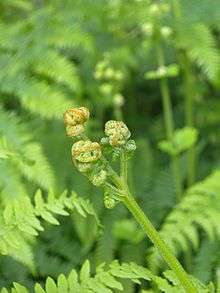Polypodiidae (plant)
| Polypodiidae | |
|---|---|
 | |
| Pteridium aquilinum | |
| Scientific classification | |
| Kingdom: | Plantae |
| Subkingdom: | Embryophyta |
| (unranked): | Tracheophyta |
| (unranked): | Euphyllophyte |
| Class: | Polypodiopsida |
| Subclass: | Polypodiidae Cronquist 1966 |
| Orders | |
| Synonyms | |
Polypodiidae is a subclass of Polypodiopsida (ferns), and of the four subclasses comprises the vast number of species. It is equivalent to the Polypodiopsida sensu stricto in the system of Smith et al. (2006).
Taxonomy
The division of the ferns (Polypodiopsida) sensu lato into four major groups has been demonstrated using both molecular[1] and morphological criteria.[2] Smith et al. (2006) carried out the first higher-level pteridophyte classification published in the molecular phylogenetic era, and considered the ferns as monilophytes, with four classes, referring to this group as Polypodiopsida sensu stricto.[1]
Later classifications renamed the group Polypodiidae, initially as a subclass of Equisetopsida sensu lato.[3] This subclass comprises leptosporangiate ferns as opposed to the remaining three subclasses which are informally referred to as eusporangiate ferns.The following diagram shows a likely phylogenic relationship between subclass Polypodiidae and the other Equisetopsida subclasses in that system[4]
|
|
In 2014, Christenhusz and Chase grouped all the fern subclasses together as Polypodiophyta[5] and in 2016 the Pteridophyte Phylogeny Group (PPG) adopted the class Polypodiopsida sensu lato for the four fern subclasses. The following cladogram shows the phylogenic relationship between the subclasses according to the PPG. The first three small subclasses being informally grouped as eusporangiate ferns, in contrast to the Polypodiidae or leptosporangiate ferns. Polypodiidae is shown as a sister group of Marattiidae.[6]
| Polypodiopsida |
| ||||||||||||||||||
Subdivision
In the PPG classification the Polypodiidae are divided into seven orders (Osmundales, Hymenophyllales, Gleicheniales, Schizaeales, Salviniales, Cyatheales, and Polypodiales), 44 families, 300 genera, and an estimated 10,323 species.[6]
These seven orders are phylogenetically related as follows:
| Polypodiidae |
| ||||||||||||||||||||||||||||||||||||
References
Bibliography
- Chase, Mark W.; Reveal, James L. (2009). "A phylogenetic classification of the land plants to accompany APG III". Botanical Journal of the Linnean Society. 161: 122–127. doi:10.1111/j.1095-8339.2009.01002.x.
- Christenhusz, M. J. M.; Zhang, X. C.; Schneider, H. (18 February 2011). "A linear sequence of extant families and genera of lycophytes and ferns". Phytotaxa. 19 (1): 7. doi:10.11646/phytotaxa.19.1.2.
- Christenhusz, Maarten J.M.; Chase, Mark W. (2014). "Trends and concepts in fern classification". Annals of Botany. 113 (4): 571–594. doi:10.1093/aob/mct299. PMC 3936591. PMID 24532607.
- Pryer, Kathleen M.; Schneider, Harald; Smith, Alan R.; Cranfill, Raymond; Wolf, Paul G.; Hunt, Jeffrey S.; Sipes, Sedonia D. (2001). "Horsetails and ferns are a monophyletic group and the closest living relatives to seed plants". Nature. 409 (6820): 618–622. doi:10.1038/35054555. PMID 11214320.
- Pteridophyte Phylogeny Group (November 2016). "A community-derived classification for extant lycophytes and ferns". Journal of Systematics and Evolution. 54 (6): 563–603. doi:10.1111/jse.12229.
- Schneider, Harald; Smith, Alan R.; Pryer, Kathleen M. (1 July 2009). "Is Morphology Really at Odds with Molecules in Estimating Fern Phylogeny?". Systematic Botany. 34 (3): 455–475. doi:10.1600/036364409789271209.
- Smith, Alan R.; Kathleen M. Pryer; Eric Schuettpelz; Petra Korall; Harald Schneider; Paul G. Wolf (2006). "A classification for extant ferns" (PDF). Taxon. 55 (3): 705–731. doi:10.2307/25065646. JSTOR 25065646.
| Wikimedia Commons has media related to Polypodiopsida. |
| Wikispecies has information related to Polypodiopsida |